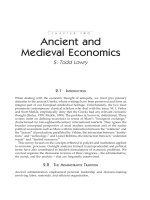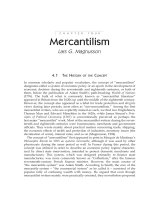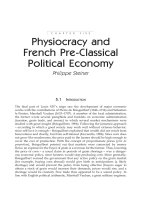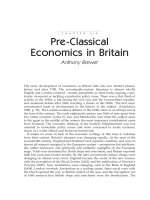Student companion to accompany fundamentals of biochemistry Akif Uman Wiley 2012
Bạn đang xem bản rút gọn của tài liệu. Xem và tải ngay bản đầy đủ của tài liệu tại đây (18.93 MB, 428 trang )
S T U D E N T C O M PA N I O N
F
U
N
D A
M
E
N
T A
L
S
O
F
Biochemistry
LIFE AT
THE MOLECULAR
LEVEL
Voet
F
O
U
Voet
R
T
H
E
D
Pratt
I
T
I
O
N
Akif Uzman Jerry Johnson Joseph Eichberg William Widger
Donald Voet Judith G. Voet Charlotte W. Pratt
This page is intentionally left blank
STUDENT COMPANION TO ACCOMPANY
FUNDAMENTALS OF
BIOCHEMISTRY
LIFE AT THE MOLECULAR LEVEL
Fourth Edition
Akif Uzman
University of Houston
Jerry Johnson
University of Houston
Joseph Eichberg
University of Houston
William Widger
University of Houston
Donald Voet
University of Pennsylvania
Judith G. Voet
Swarthmore College
Charlotte W. Pratt
Seattle, Washington
JOHN WILEY & SONS, INC
Cover Designer Madelyn Lesure
Cover Illustration Norm Christiansen
Cover Photos
(Vitruvian Man): © Odysseus/Alamy and © Dennis Hallinan/Alamy
Molecular structures clockwise from top: based on X-ray structures that were respectively determined
by Richard Dickerson and Horace Drew, Caltech; Gerard Bunick, University of Tennessee; Thomas
Steitz, Yale University; Alfonso Mondragón, Northwestern University; Venki Ramakrishnan, MRC
Laboratory of Molecular Biology, Cambridge, U.K.; Andrew Leslie and John Walker, MRC Laboratory
of Molecular Biology, Cambridge, U.K.
Founded in 1807, John Wiley & Sons, Inc. has been a valued source of knowledge and understanding for
more than 200 years, helping people around the world meet their needs and fulfill their aspirations. Our
company is built on a foundation of principles that include responsibility to the communities we serve and
where we live and work. In 2008, we launched a Corporate Citizenship Initiative, a global effort to
address the environmental, social, economic, and ethical challenges we face in our business. Among the
issues we are addressing are carbon impact, paper specifications and procurement, ethical conduct within
our business and among our vendors, and community and charitable support. For more information,
please visit our website: www.wiley.com/go/citizenship.
Copyright © 2012
John Wiley & Sons, Inc.
All rights reserved. No part of this publication may be reproduced, stored in a retrieval system or
transmitted in any form or by any means, electronic, mechanical, photocopying, recording, scanning or
otherwise, except as permitted under Sections 107 or 108 of the 1976 United States Copyright Act,
without either the prior written permission of the Publisher, or authorization through payment of the
appropriate per-copy fee to the Copyright Clearance Center, Inc., 222 Rosewood Drive, Danvers, MA
01923, website www.copyright.com. Requests to the Publisher for permission should be addressed to the
Permissions Department, John Wiley & Sons, Inc. 111 River Street, Hoboken, NJ 07030-5774, (201)
748-6011, fax (201) 748-6008, website />To order books or for customer service, please call 1-800-CALL WILEY (225-5945).
Student Companion (paperback)
ISBN-13 978-1-1182-1827-3
Printed in the United States of America
10 9 8 7 6 5 4 3 2 1
Contents
1
Introduction to the Chemistry of Life
1
2
Water
9
3
Nucleotides, Nucleic Acids, and Genetic Information
21
4
Amino Acids
29
5
Proteins: Primary Structure
40
6
Proteins: Three-Dimensional Structure
49
7
Protein Function: Myoglobin and Hemoglobin, Muscle
Contraction, and Antibodies
60
8
Carbohydrates
72
9
Lipids and Biological Membranes
80
10
Membrane Transport
90
11
Enzymatic Catalysis
96
12
Enzyme Kinetics, Inhibition, and Control
108
13
Biochemical Signaling
121
14
Introduction to Metabolism
128
15
Glucose Catabolism
137
16
Glycogen Metabolism and Gluconeogenesis
146
17
Citric Acid Cycle
154
18
Electron Transport and Oxidative Phosphorylation
160
19
Photosynthesis
169
20
Lipid Metabolism
176
21
Amino Acid Metabolism
188
22
Mammalian Fuel Metabolism: Integration and Regulation
197
23
Nucleotide Metabolism
203
24
Nucleic Acid Structure
210
25
DNA Replication, Repair, and Recombination
219
26
Transcription and RNA Processing
230
27
Protein Synthesis
238
28
Regulation of Gene Expression
247
Answers to Questions
AQ-1
Solutions to Problems
SP-1
Welcome to biochemistry! You are about to become acquainted with one of the
most exciting scientific disciplines. The biotechnology industry, with its roots in
molecular genetics, is one of the most visible manifestations of the explosion of
biochemical knowledge that has occurred during our lifetime. Drug design and
novel approaches such as gene therapy rely on the fundamental knowledge of the
chemistry of biological molecules, particularly proteins. Our most common
diseases (e.g., diabetes and heart disease) have pleiotropic multifaceted
physiological effects that are best understood in terms of biochemistry. You will
soon discover that biochemistry’s impact on our lives cannot be over-emphasized.
We are excited to bring you an ever-expanding understanding of this magnificent
subject!
Learning biochemistry is not easy but it can be fun! Most students discover
that biochemistry is a synthetic science, merging knowledge of general chemistry,
organic chemistry, and biology. Hence, a more mature and creative kind of
thinking is required to gain a deep understanding of biochemistry. In addition to a
solid foundation in chemistry and biology, you will need to recognize and
assimilate some general principles from other disciplines within biology, including
physiology, genetics, and cell biology. In this respect, biochemistry is not all that
different from nonscientific pursuits that require some degree of “lateral thinking”
across disciplines.
This Student Companion accompanies Fundamentals of Biochemistry Fourth
Edition by Donald Voet, Judith G. Voet, and Charlotte W. Pratt. It is designed to
help you master the basic concepts and exercise your analytical skills as you work
your way through the textbook. Each chapter of the Student Companion is divided
into four parts, beginning with a general summary reminding you of the topics
covered in that chapter. This is followed by a section called Essential Concepts,
which provides an overview of the main facts and ideas that are essential for your
understanding of biochemistry. This can be regarded as a set of brief notes for each
chapter, alerting you to the key facts you need to commit to memory and to the
concepts you need to master. You will soon notice that biochemical knowledge is
cumulative: new concepts often rely on a solid understanding of previously
presented concepts. Hence, one of the key goals of this Companion is to help you
gain this understanding. The third and last section is the Questions. These are
organized in a manner to help you gain a firm understanding of each section of a
chapter. Some questions ask you to recall essential facts while others exercise your
problem-solving skills. Answers to all of the questions are provided at the end of
the Student Companion. However, you do yourself a great disservice by turning to
them too soon. Don’t know the answer right away? Keep trying! Go back to the
text to find clues for yourself. Use the answers to check yours, not to fill in a
temporary void in your understanding. The Solutions to all end of chapter
problems in the text can be found after the Answers to Questions.
As a new addition to this edition of the Student Companion, we have added
three new features to select chapters: Behind the Equations, Calculation Analogies
and Play It Forward. Behind the Equations is a section that tackles key equations in
Biochemistry. This section will provide insights and learning strategies for using
and understanding what these equations are really telling us, and how to use them
intuitively. The Calculation Analogies section will tackle key equations
conceptually using simple analogies that will help students understand how to
solve problems. The Play It Forward Section will take critical concepts from early
chapters and integrate them into material in later chapters to help students see how
the content continues to build upon itself, hopefully allowing students to synthesize
Biochemistry as a discipline.
“How should I study biochemistry beyond reading the textbook and working
in this Companion?” is a likely question from students. The phrase, “if you don’t
use it, you lose it” applies here. It is pointless to simply read your biochemistry
textbook over and over. Unless you are actively engaged in working with the
material, you become a passive reader. Active engagement includes using your
hands to work problems, drawing pictures, or writing an outline or flow chart. As
you read, ask yourself questions and seek answers from your text and your
instructor. By doing these things, you use the material, and it becomes more
efficiently transferred to your long-term memory.
“How often should I study biochemistry?” is also a common question. Most
instructors agree that frequent short study sessions—even daily—will pay greater
dividends than a single long session once a week. Because short-term memory lasts
just a few minutes, take a few minutes after every class to review your notes.
Similarly, stop reading your text, and review on paper with diagrams, word charts,
flow diagrams, what you just read. Talk biochemistry with anyone who will listen.
Form a study group to enrich your knowledge and test your memory. All these
activities will result in the transfer of knowledge from short-term memory to longterm memory. In other words, the more you use biochemistry, the better you know
it and the more fun you will have with it.
One of the truly most satisfying ways to learn biochemistry is to apply its
principles and findings to problems that integrate your knowledge. To this end, Dr.
Kathleen Cornely has developed numerous case studies that test your analytical
skills. You will find these case studies on the Fundamentals of Biochemistry 4e
Student Companion Site at www.wiley.com/college/voet. They can also be found
in
the
Fundamentals
of
Biochemistry
4e
WileyPLUS
course
(www.wileyplus.com). Topics for the case studies were chosen to cover a range of
interesting areas relevant to biochemistry. The cases themselves are based on data
from research reports as well as clinical studies. The prerequisites include material
that you are likely to be studying in biochemistry class, but occasionally include
concepts from genetics and immunology on a level likely to be encountered in a
first-year general biology course. The answers to the questions posed in these case
studies can be obtained from your instructor.
We have many people to thank for helping us get this Companion to you. First
and foremost, we would like to acknowledge Associate Editor, Ms. Aly Rentrop,
and Production Editor, Ms. Sandra Dumas. In addition, we would like to
acknowledge Ms. Petra Recter, Associate Publisher for Physics and Chemistry at
John Wiley and Sons for her support of this project. We are also indebted to
Caroline Breitenberger of The Ohio State University and Laura Mitchell of St.
Joseph’s University for their much-appreciated reviews of our original draft. We
would also like to thank our students at Swarthmore College, the University of
Houston, and the University of Houston-Downtown for pointing out errors and
ambiguities in earlier drafts of this work. It is still possible that errors persist, and
so we would greatly appreciate being alerted to them. Please forward you
comments to Akif Uzman ().
Akif Uzman
Jerry Johnson
Joseph Eichberg
William Widger
Charlotte W. Pratt
Donald Voet
Judith G. Voet
This page is intentionally left blank
1
Introduction to the Chemistry of Life
This chapter introduces you to life at the biochemical and cellular level. It begins with a
discussion of the chemical origins of life and its early evolution. This discussion continues into
ideas and theories about the evolution of organisms, followed by a brief introduction to
taxonomy and phylogeny viewed from a molecular perspective. The chapter concludes with an
introduction to the basic concepts of thermodynamics and its application to living systems.
Biochemistry, like all other sciences, is a based on the measurement of observable phenomena.
Hence, it is important to become familiar with the conventions used to measure energy and mass.
Box 1-2 presents the essential biochemical conventions that we will encounter throughout
Fundamentals of Biochemistry.
Essential Concepts
The Origin of Life
1.
Living matter consists of a relatively small number of elements, of which C, N, O, H, Ca,
P, K, and S account for ~98% of the dry weight of most organisms (which are 70% water).
These elements form a variety of reactive functional groups that participate in biological
structure and biochemical reactions.
2.
The current model for the origin of life proposes that organisms arose from the
polymerization of simple organic molecules to form more complex molecules, some of
which were capable of self-replication.
3.
Most polymerization reactions involving the building of small organic molecules into
larger more complex ones occur by the formation of water. This is called a condensation
reaction.
4.
A key development in the origin of life was the formation of a membrane that could
separate the critical molecules required for replication and energy capture from a
potentially degradative environment.
5.
Complementary surfaces of molecules and macromolecules provide a template for
biological specificity (e.g., macromolecular assembly, enzyme activity, and expression and
replication of the genome).
6.
Modern cells can be classified as either prokaryotic or eukaryotic. Eukaryotic cells are
distinguished by a variety of membrane-bounded organelles and an extensive cytoskeleton.
2 Chapter 1 Introduction to the Chemistry of Life
Organismal Evolution
7.
Prokaryotes show a limited range of morphologies but very diverse metabolic capabilities.
8.
Phylogenetic evidence based on comparisons of ribosomal RNA genes have been used by Woese
and colleagues to group all organisms into three domains: archaea, bacteria, and eukarya.
9.
The evolution of sexual reproduction marks an important step of the evolution of
organisms, because it allows for genetic exchanges that lead to an increase in the
adaptability of a population of organisms to changing environments.
10.
Eukaryotes contain several membrane-bounded structures, such as mitochondria and
chloroplasts, which may be descended from ancient symbionts.
11.
Archaea represent a third domain or branch of life in the three-domain system of
classification. While they outwardly resemble bacteria, their genomes and the proteins
encoded in them more closely resemble those of eukaryotes.
12.
Biological evolution is not goal-directed, requires some built-in sloppiness, is constrained
by its past, and is ongoing.
13.
Natural selection directs the evolution of species.
Thermodynamics
14.
The first law of thermodynamics states that energy (U) is conserved; it can neither be
created nor destroyed.
15.
Enthalpy (H) is a thermodynamic function that is a sum of the energy of the system and the
product of the pressure and the volume (PV). Since biochemical processes occur at constant
pressure and have negligible changes in volume, the change of energy of the system is
nearly equivalent to the change in enthalpy (ΔU ≈ ΔH).
16.
The second law of thermodynamics states that spontaneous processes are characterized by
an increase in the entropy of the universe, that is, by the conversion of order to disorder.
17.
The spontaneity of a process is determined by its free energy change (ΔG = ΔH – TΔS).
Spontaneous reactions have ΔG < 0 (exergonic) and nonspontaneous reactions have ΔG > 0
(endergonic).
15.
For any process at equilibrium, the rate of the forward reaction is equal to the rate of the
reverse reaction, and ΔG = 0.
18. Energy, enthalpy, entropy, and free energy are state functions; that is, they depend only on
the state of the system, not its history. Hence, they can be measured by considering only the
initial and final states of the system and ignoring the path by which the system reached its
final state.
Chapter 1 Introduction to the Chemistry of Life 3
19.
The entropy of a solute varies with concentration; therefore, so does its free energy. The
free energy change of a chemical reaction depends on the concentration of both its
reactants and its products.
20.
For the general reaction
aA + bB
cC + dD
the free energy change is given by the following relationship:
21.
The equilibrium constant of a chemical reaction is related to the standard free energy of the
reaction when the reaction is at equilibrium (ΔG = 0) as follows:
ΔG° = –RT ln Keq
where Keq is the equilibrium constant of the reaction:
The equilibrium constant can therefore be calculated from standard free energy data and
vice versa.
22.
The equilibrium constant varies with temperature by the relationship:
where ΔH° and ΔS° represent enthalpy and entropy in the standard state. A plot of Keq
versus 1/T, known as a van’t Hoff plot, permits the values of ΔH° and ΔS° (and therefore
ΔG° at any temperature) to be determined from measurements of Keq at two (or more)
temperatures.
23.
The biochemical standard state is defined as follows: The temperature is 25°C, the pH is
7.0, and the pressure is 1 atm. The activities of reactants and products are taken to be the
total activities of all their ionic species, except for water, which is assigned an activity of 1.
[H+] is also assigned an activity of 1 at the physiologically relevant pH of 7. These
conditions are different than the chemical standard state, so that the biochemical standard
free energy is designated as ΔG°′ and in the chemical standard state is ΔG°. We assume
that activity equals molarity for dilute solutions.
4 Chapter 1 Introduction to the Chemistry of Life
24.
An isolated system cannot exchange matter or energy with its surroundings. A closed
system can exchange only energy with its surroundings. A closed system inevitably reaches
equilibrium. Open systems exchange both matter and energy with their surroundings and
therefore cannot be at equilibrium. Living organisms must exchange both matter and
energy with their surroundings and are thus open systems. Living organisms tend to
maintain a constant flow of matter and energy, referred to as the steady state.
25.
Living systems can respond to slight perturbations from the steady state to restore the
system back to the steady state.
26.
The recovery of free energy from a biochemical process is never total, and some energy is
lost to the surroundings as heat. Hence, while the system becomes more ordered, the
surroundings experience an increase in entropy.
27.
Enzymes accelerate the rate at which a biochemical process reaches equilibrium. They
accomplish this by interacting with reactants and products to provide a more energetically
favorable pathway for the biochemical process to take place.
Key Equations
Be sure to know the conditions for which the following thermodynamics equations apply and be
able to interpret their meaning.
Chapter 1 Introduction to the Chemistry of Life 5
Calculation Analogy for Determining Gibbs Free Energy for a Chemically
Defined System
The change in Gibbs Free Energy (ΔG) is used to determine whether or not a process is
spontaneous or non-spontaneous under a given set of conditions (state of a thermodynamic
system).
For a thermodynamic system that is a chemical process such as:
aA + bB
cC + dD
The ΔG of this process can be determined using equation 7 (see Key Equations above):
The typical student approaches a problem utilizing this equation with a ‘plug and chug’
mentality, without understanding exactly what the equation is trying to tell them.
Ultimately, this equation is informing us how far a thermodynamic system is from
equilibrium (ΔG = 0). A simple mathematical analogy can be used to demonstrate this
concept and provide a visual perspective when solving problems requiring the use of this
equation.
Consider a number line used in mathematics:
0
Number lines are constructed with a particular reference in mind; here, the number zero. Any
system located on the right-hand side of zero on the number line is characterized by a
positive number and would represent a system that is non-spontaneous under the specified
conditions. Any system located on the left-hand side of zero on the number line is
characterized by a negative number and would represent a system that is spontaneous under
the specified conditions. Since a system at thermodynamic equilibrium has a ΔG = 0, then
any value of ΔG ≠ 0 would represent a thermodynamic system not at equilibrium.
We could use a number line to plot the position of any thermodynamic system not at
equilibrium in reference to thermodynamic equilibrium (ΔG = 0). In doing so, we could
physically measure the distance between zero and the position of the thermodynamic system
that is not at equilibrium using a ruler. You could plot the number – 30 on the number line,
and this position would correspond to a thermodynamic system with a ΔG = – 30 kJymol–1:
6 Chapter 1 Introduction to the Chemistry of Life
Spontaneous
Equilibrium
– 30
– 20
–10
Non-spontaneous
0
You could use a ruler to measure the distance between the system at that state
(ΔG = – 30 kJymole–1) and thermodynamic equilibrium (ΔG =0). Thus, it is convenient and
accurate to say that ΔG is a measure of how far a thermodynamic system is from equilibrium.
While we cannot use an actual ruler to gain an appreciation of this in real life, the further a
thermodynamic system is from equilibrium, the more useful work that system is capable of
performing.
Solving a ΔG equation for a chemical system using equation (1) is analogous to using a
number line. In order to determine the ΔG of a process, we need to know two pieces of
information about that system (or reference points).
Equation (1) provides you with that information. Ultimately, the ΔG equation can be divided
into two mathematical terms: the “ΔG°” term and the “RTln([C]c[D]d/[A]a[B]b)” term. These
two mathematical terms are your reference points!
ΔG° is the ΔG of the system at the chemical standard state (25° C, 1 atm, and all reactants
with an activity of 1). This represents the position of the reaction under the defined
conditions. It is an arbitrary state that we can now use a reference point.
The second mathematical term of equation (1) is the current state of the thermodynamic
system as defined by the variables of the problem you are trying to solve. Specifically, it
provides the temperature and current molar concentrations of all reacting species in the
thermodynamic system. This provides a second reference point. Using these two pieces of
information, you now can calculate the ΔG of that system, and gain an appreciation for how
far that system is from thermodynamic equilibrium!
Questions
The Origin of Life
1.
What are the elements that account for 98% of the dry weight of living cells?
2.
In what critical ways was the atmosphere of the primitive earth different than the earth’s
current atmosphere?
3.
What is the rationale and significance of the Miller and Urey experiments?
4.
What was, and continues to be, the source of atmospheric oxygen?
Chapter 1 Introduction to the Chemistry of Life 7
5.
Examine the reaction shown below for the condensation and hydrolysis of lactose (two
covalently linked sugars, a disaccharide). Circle the functional groups that will form water
during the condensation.
6.
The condensation of two functional groups can result in the formation of another common
functional group, which can be referred to as a compound functional group. Examine the
functional groups in Table 1-2. Which compound functional groups are the combination of
two other functional groups found in that figure? Show how these compound functional
groups form.
Cellular Architecture
7.
Draw a schematic diagram of an eukaryotic cell showing its principal organelles.
8.
Give the principal distinguishing feature(s) of each pair of terms:
(a) Prokaryote and eukaryote
(b) Cytosol and cytoplasm
(c) Endoplasmic reticulum and cytoskeleton
9.
Living organisms are classified into three domains: _________________,
__________________, and __________________.
8 Chapter 1 Introduction to the Chemistry of Life
10.
What is the most compelling evidence that mitochondria and chloroplasts represent
descendents of symbiotic bacteria that lived inside of ancient eukaryotic cells?
11. What is the relationship between mutation and genetic variation in a population of
organisms? Of what significance is it to evolution?
Thermodynamics
12.
Distinguish between enthalpy and energy. Under what conditions are they equivalent?
13.
What does it mean when q and w are positive?
14.
When crystalline urea is dissolved in water, the temperature of the solution drops
precipitously. Does the enthalpy of the system increase or decrease? Explain.
15.
List and define the four major thermodynamic state functions.
16.
Which of the following pairs of states has higher entropy?
(a) Two separate beakers of NaCl and KCH3COO in solution and a beaker containing a
solution of both salts.
(b) A set of dice in which all the dice show 6 dots on the top side and a set of dice in
which the 6’s show up on one of the side faces.
(c) A small symmetric molecule that can form a polymer through reaction at either end,
and a small asymmetric molecule that can polymerize from only one end.
17.
Rationalize the temperature dependence of Gibbs free energy changes when both the
enthalpy and entropy terms are positive values or when they are both negative values.
18. Hydrogen gas combines spontaneously with oxygen gas to form water
2 H2 + O2 → 2 H2O
Which term, enthalpy or entropy, predominates in the equation for the Gibbs free energy?
How are the surroundings affected by this reaction?
19.
Evaluate the following statement: Enzymes accelerate the rate of a reaction by increasing
the spontaneity of the reaction.
20. Based on your reading in this chapter, suggest simple criteria for a reasonable definition of
life.
21.
The breakdown of glucose to pyruvate utilizes the free energy of 2 ATP molecules;
however, the synthesis of glucose from pyruvate requires 4 ATP. Using the basic ideas of
thermodynamics presented in this chapter, provide a thermodynamic explanation.
Hint: Think about the relationship ΔG = ΔH – TΔS in your argument.
2
Water
This chapter introduces you to the unique properties of water and to acid–base reactions. The
discussion of water begins with a look at its structure and how its polarity provides a basis for
understanding its powers as a solvent. You are then introduced to the hydrophobic effect,
osmosis, and diffusion. The chemical properties of water are then described, beginning with
the ionization of water, which sets the stage for a discussion of acid–base chemistry and the
behavior of weak acids and buffers. This discussion includes the Brønsted–Lowry definition
for acids and bases, the definition of pH, and the derivation of the Henderson–Hasselbalch
equation. As we shall see in subsequent chapters, a solid understanding of acid–base equilibria
is fundamental to understanding key aspects of amino acid biochemistry, protein structure,
enzyme catalysis, transport across membranes, energy metabolism, and other metabolic
transformations.
Essential Concepts
1.
Water is essential to biochemistry because:
(a) Biological macromolecules assume specific shapes in response to the chemical and
physical properties of water.
(b) Biological molecules undergo chemical reactions in an aqueous environment.
(c) Water is a key reactant in many reactions, usually in the form of H+ and OH– ions.
(d) Water is oxidized in photosynthesis to produce molecular oxygen, O2, as part of the
process that converts the sun’s energy into usable chemical form. Expenditure of
that energy under aerobic conditions leads to the reduction of O2 back to water.
Physical Properties of Water
2.
The structure of water closely approximates a tetrahedron with its two hydrogen atoms and
the two lone pairs of electrons of its oxygen atom “occupying” the vertices of the
tetrahedron.
3.
The high electronegativity of oxygen relative to hydrogen results in the establishment of a
permanent dipole in water molecules.
4.
The polar nature of water results in negative portions of the molecule being attracted to the
positive portions of neighboring water molecules by a largely electrostatic interaction
known as the hydrogen bond.
5.
Hydrogen bonds are represented as D—H···A, where D—H is a weakly acidic compound
so that the hydrogen atom (H) has a partial positive charge, and A is a weakly basic group
10
Chapter 2 Water
that bears lone pairs of electrons. A is often an oxygen atom or a nitrogen atom
(occasionally sulfur).
6.
Water is strongly hydrogen bonded, with each water molecule participating in four
hydrogen bonds with its neighbors; two in which it donates and two in which it accepts.
Hydrogen bonds commonly form between water molecules and the polar functional
groups of biomolecules, or between the polar functional groups themselves.
7.
The strongly hydrogen bonded character of water is responsible for many of its
characteristic properties, most notably:
(a) A high heat of fusion, which allows water to act as a heat sink, such that greater heat
loss is necessary for the freezing of water compared to other substances of similar
molecular mass.
(b) A high heat of vaporization, such that relatively more heat must be input to vaporize
water compared to other substances of similar molecular mass.
(c) An ability to dissolve most polar compounds.
(d) An open structure makes ice less dense than liquid water, thereby making ice float,
insulating the water beneath it, and inhibiting total freezing of large bodies of water.
8.
A variety of weak electrostatic interactions are critical to the structure and reactivity of
biological molecules. These interactions include, in order of increasing strength, London
dispersion forces, dipole–dipole interactions, hydrogen bonds, and ionic interactions (see
Table 2-1).
9.
Water is an excellent solvent of polar and ionic substances due to its property of
surrounding polar molecules and ions with oriented shells of water, thereby attenuating the
electrostatic forces between these molecules and ions.
10. The tendency of water to minimize its contact with nonpolar (hydrophobic) molecules is
called the hydrophobic effect. This effect is largely driven by the increase in entropy
caused by the necessity for water to order itself around nonpolar molecules. This causes
the nonpolar molecules to aggregate, thereby reducing the surface area that water must
order itself about. Consequently, nonpolar substances are poorly soluble in aqueous
solution.
11. Many biological molecules have both polar (or charged) and nonpolar functional groups
and are therefore simultaneously hydrophilic and hydrophobic. These molecules are said
to be amphiphilic or amphipathic.
12. Osmosis is the movement of solvent across a semipermeable membrane from a region of
lower concentration of solute to a region of higher concentration of solute. Osmotic
pressure of a solution is the pressure that must be applied to the solution to prevent an
inflow of solvent. Hence, an increase in solute concentration results in an increase in
osmotic pressure.
Chapter 2 Water
13. Diffusion is the random movement of molecules in solution (or in the gas phase). It is
responsible for the movement of solutes from a region of high concentration to a region of
low concentration.
Chemical Properties of Water
14. Water is a neutral, polar molecule that has a slight tendency to ionize into H+ and OH–.
However, the proton is never free and binds to a water molecule to form H3O+ (hydronium
ion).
15. The ionization of water is described as an equilibrium between the unionized water
(reactant) and its ionized species (products)
H+ + OH–
H2O
In which
K =
[H+][OH–]
[H2O]
Since in dilute aqueous solution, the concentration of water is essentially constant (55.5
M), the concentration of H2O is incorporated into the value of K, which is referred to as
Kw, the ionization constant of water.
Kw = [H+][OH–]
16. The values of both H+ and K are inconveniently small; hence, their values are more
conveniently expressed as negative logarithms, so that
pH = – log [H+]
pK = – log K
17. According to the Brønsted–Lowry definition, an acid is a substance that can donate a
proton, and a base is a substance that can accept a proton. The strength of a weak acid is
proportional to its dissociation constant, which is expressed as
K =
[H+][A–]
[HA]
18. The pH of a solution of a weak acid is determined by the relative concentrations of the
acid and its conjugate base. The equilibrium expression for the dissociation of a weak acid
can be rearranged to
[A–]
pH = pK + log [HA]
11
12
Chapter 2 Water
This relationship is known as the Henderson–Hasselbalch equation. When the
concentration of a weak acid is equal to the concentration of its conjugate base, pH = pK.
Hence, the stronger the acid, the lower its pK (see Table 2-4).
19. Solutions of a weak acid at pH’s near its pK resist large changes in pH as OH– or H+ is
added. Added protons react with the weak acid’s conjugate base to reform the weak acid;
whereas added OH– combines with the acid to form its conjugate base and water. A
solution of a weak acid and its conjugate base (in the form of a salt) is referred to as a
buffer. Buffers are effective within 1 pH unit of the pK of the component acid.
Key Equations
Henderson–Hasselbalch equation:
[A–]
pH = pK + log [HA]
Behind the Equations
Which acids are defined by a pK value?
The key to understanding which acids are defined by a pK value (here we use an abbreviation
for pKa, the dissociation constant for a weak acid) and which are not is understanding the
behavior of strong and weak acid chemistry at equilibrium. Ultimately, only weak acids are
defined by K values and thus pK values. This can be demonstrated both conceptually and
mathematically. Conceptually, strong acids are defined as those that dissociate completely in
aqueous solution:
HA
H+ + A–
The unidirectional arrow above implies that as the solution of strong acid approaches
equilibrium, the molar concentration of HA becomes smaller and smaller, approaching zero.
Once the strong acid has reached equilibrium, there is virtually no HA remaining in solution.
Mathematically, the equilibrium acid dissociation constant is defined as:
[H+][A–]
K = [HA]
(Text Equation 2–5)
And the pK is defined as:
pK= –log K
(Text Equation 2–6)
If a strong acid dissociates completely in aqueous solution, the concentration of HA, and thus
the denominator of Equation 2 approaches the limit of zero. As the denominator of a fraction
becomes smaller and smaller, the value of that fraction becomes larger and larger, approaching
Chapter 2 Water
the limit of infinity. Since Equation 2-5 refers to concentrations at equilibrium, the
denominator of Equation 2-5 would be 0, and the value of K is therefore undefined. Thus, it is
not appropriate to define a strong acid with a K value.
Because K approaches infinity, pK would approach negative infinity. Again, this makes it
inappropriate for describing the strength of a strong acid.
However, the situation is very different for weak acids. Weak acids are defined as those acids
that are incompletely dissociated at equilibrium in aqueous solution:
HA
H+ + A–
The bidirectional arrow above implies that at equilibrium, both reactants and products will be
present in measurable amounts Thus, the value of K will not be undefined, and the value of pK
will not approach negative infinity. This allows weak acids to have measurable values of both
K and pK.
What does pK really tell us about a weak acid?
The value of pK provides a basis for comparing the strengths of weak acids. Since K is an
equilibrium dissociation constant, it indicates the tendency and extent to which a weak acid
will dissociate to a proton and the conjugate base of the weak acid at equilibrium. The larger
the value of K, the larger the value of the numerator in Equation 2-5. The larger the value of K,
the smaller the value of pK (Equation 2–6).
In order to understand the concept of pK, one must realize that the pK value is a relative
measure of the affinity a weak acid has for its proton. By definition, affinity is the attraction
between two things, in this case, the attractive force between the conjugate base of a weak acid
and the proton. Consider the following analogy: two men are walking down the street. The first
man has $100 in his wallet and is a miser with his money, while the second man has $100 in
his wallet and is well known for his generosity.
Which of the two men has a higher affinity for (or desire to hold onto) his $100? Naturally, the
first man will have a higher affinity for his $100, and is less likely to give up his money
compared to the second man. The first man is analogous to a weaker acid while the second
man is analogous to a stronger acid. A weaker acid holds on to a proton with higher affinity
compared to a stronger acid.
In other words, a stronger acid has a lower proton affinity and a lower pK value, whereas a
weaker acid has a higher proton affinity and a higher pK value. As a result, the numerator of
Equation 2-5 and the ultimate value of K for a stronger acid will be larger than the numerator
of Equation 2-5 and value of K for a weak acid. Finally, a weak acid must have a lower pK
value than a weaker, weak acid. Relatively stronger acids have low proton affinities and lower
pK values while weaker acids have higher proton affinities and higher pK values.
13
14
Chapter 2 Water
This can be summarized as:
The strength of a weak acid is inversely proportional to the affinity of that acid for its proton and
inversely proportional to the pK of that acid.
How can we use this information when solving problems with the Henderson – Hasselbalch
equation?
The Henderson – Hasselbalch equation describes the relationship between the pK of a weak
acid, the pH of a solution, and the ratio of the molar concentrations of the weak acid and
conjugate base at equilibrium. Two important relationships become evident when one looks at
two different scenarios with the same weak acid. Consider the Sample Calculation 2-2 in the
textbook:
Calculate the pH of a 2 L solution containing
10 mL of 5 M acetic acid and 10 mL of 1 M
sodium acetate.
First calculate the concentrations of the acid
and conjugate base, expressing all
concentrations in units of moles per liter.
Acetic acid: (0.010 L)(5M) / (2L) = 0.025 M
Sodium acetate: (0.010 L)(1 M) / (2L) =
0.0050M
Substitute the concentrations of the acid and
conjugate base into the HendersonHasselbalch equation. Find the pKa for acetic
acid in Table 2-4.
pH = pKa + log([acetate]/[acetic acid])
pH = 4.76 + log (0.0050/0.025)
pH = 4.76 – 0.70
pH = 4.06
The first important relationship is revealed if
we alter the problem slightly. What would the
pH of the solution be if the concentration of
acetate was equal to the concentration of
acetic acid?
pH = 4.76 + log (0.025/0.025)
Chapter 2 Water
In this scenario, the ratio of the conjugate base to acid is equal to 1.0. The log of 1.0 = 0, so
this equation reduces to:
pH = pK
If the concentrations of the weak acid and conjugate base are equal, then the pH of the solution
is equal to the pK of the weak acid. One of the first steps you should employ when solving
Henderson – Hasselbalch problems is to look at the molar ratio of the conjugate base to the
weak acid: the closer these values are to each other, the closer the pH of the environment will
be to the pKa of the weak acid. In fact, because the Henderson – Hasselbalch equation is
logarithmic, for every order of magnitude 10-fold difference between the concentrations of
the conjugate base and weak acid at equilibrium, the pH will differ by 1 unit from the pK.
Notice that in the original Sample Calculation 2-2 from the textbook, the molar concentrations
of the conjugate base and weak acid were not even 10-fold different from each other, and thus
the pH of the solution at equilibrium was not even 1 pH unit different from the pK value (pH =
4.06 vs. pK = 4.76).
The second relationship has to do with the relative concentrations of acid and conjugate base
depending on the values of pH and pK. For the original Sample Calculation 2-2, the pH of the
solution is lower than the pK of the acid. Notice that when the pH of the solution is lower than
the value of the pK of the weak acid, the ratio of conjugate base to acid favors the acid form
(HA), or the denominator of the equation.
Now consider what would happen if the pH were instead equal to 5.50 in this scenario? What
would the ratio of conjugate base to acid be then? Which molecular species predominates?
Which term in Equation 2-5 is larger?
Application of the Henderson – Hasselbach equation yields (where X refers to ratio of the
concentrations of base to acid)
5.50 = 4.76 + log X
5.50 – 4.76 = log X
100.74 = X
X = 5.50
Notice now that when the pH of the solution is higher than the pK of the acid, then the ratio of
conjugate base-to-acid favors the conjugate base (A–), or the numerator of the equation.
Understanding this relationship between pH, pK and the ratio of conjugate base to acid is key
to predicting the correct outcomes of Henderson – Hasselbalch problems and can be
summarized as:
15









